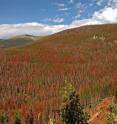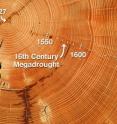Climate change could cripple southwestern forests
Combine the tree-ring growth record with historical information, climate records, and computer-model projections of future climate trends, and you get a grim picture for the future of trees in the southwestern United States. That's the word from a team of scientists from Los Alamos National Laboratory, the U.S. Geological Survey, the University of Arizona, and other partner organizations. If the Southwest is warmer and drier in the near future, widespread tree death is likely and would cause substantial changes in the distribution of forests and of species, the researchers report this week in the journal Nature Climate Change.
Southwestern forests grow best when total winter precipitation is high combined with a summer and fall that aren't too hot and dry.
The team developed a Forest Drought-Stress Severity Index that combines the amount of winter precipitation, late summer and fall temperatures, and late summer and fall precipitation into one number.
"The new 'Forest Drought-Stress Index' that Williams devised from seasonal precipitation and temperature-related variables matches the records of changing forest conditions in the Southwest remarkably well," said co-author Thomas W. Swetnam, director of the UA Laboratory of Tree-Ring Research.
"Among all climate variables affecting trees and forests that have ever been studied, this new drought index has the strongest correlation with combined tree growth, tree death from drought and insects, and area burned by forest fires that I have ever seen."
A. Park Williams of Los Alamos National Laboratory in New Mexico is the lead author of the paper, "Temperature as a potent driver of regional forest drought stress and tree mortality." Six of the paper's 15 authors are at the UA. A complete list of authors is at the bottom of this release.
To figure out which climate variables affect forests, the researchers aligned some 13,000 tree core samples with known temperature and moisture data. The team also blended in events known from tree-ring, archaeological and other paleorecords, such as the late 1200s megadrought that drove the ancient Pueblo Indians out of longtime settlements such as those at Mesa Verde, Colo.
By comparing the tree-ring record to climate data collected in the Southwest since the late 1800s, the scientists identified two climate variables that estimate annual southwestern tree-growth variability with exceptional accuracy: total winter precipitation and average summer-fall atmospheric evaporative demand, a measure of the overall dryness of the environment.
Williams said, "Atmospheric evaporative demand is primarily driven by temperature. When air is warmer, it can hold more water vapor, thus increasing the pace at which soil and plants dry out. The air literally sucks the moisture out of the soil and plants."
Finding that summer-fall atmospheric evaporative demand is just as important as winter precipitation has critical implications for the future of southwestern forests, he said.
These trends, the researchers noted, are already occurring in the Southwest, where temperatures generally have been increasing for the past century and are expected to continue to do so because of accumulating greenhouse gases in the atmosphere.
There still will be wet winters, but increased frequency of warmer summers will put more stress on trees and limit their growth after wet winters, the study reports.
"We can use the past to learn about the future," Williams said. "For example, satellite fire data from the past 30 years show that there has been a strong and exponential relationship between the regional tree-ring drought-stress record and the area of southwestern forests killed by wildfire each year. This suggests that if drought intensifies, we can expect forests not only to grow more slowly, but also to die more quickly."
The study points out that very large and severe wildfires, bark-beetle outbreaks and a doubling of the proportion of dead trees in response to early 21st-century warmth and drought conditions are evidence that a transition of southwestern forest landscapes toward more open and drought-tolerant ecosystems may already be underway.
And while 2000s drought conditions have been severe, the regional tree-ring record indicates there have been substantially stronger megadrought events during the past 1,000 years.
The strongest megadrought occurred during the second half of the 1200s and is believed to have played an important role in the abandonment of ancient Puebloan cultural centers throughout the Southwest. The most recent megadrought occurred in the late 1500s and appears to have been strong enough to kill many trees in the Southwest.
"When we look at our tree-ring record, we see this huge dip in the 1580s when all the tree rings are really tiny," Williams said. "Following the 1500s megadrought, tree rings get wider, and there was a major boom in new trees. Nearly all trees we see in the Southwest today were established after the late-1500s drought, even though the species we evaluated can easily live longer than 400 years. So that event is a benchmark for us today. If forest drought stress exceeds late 1500 levels, we expect that a lot of trees are going to be dying."
Will future forest drought-stress levels reach or exceed those of the megadroughts of the 1200s and 1500s?
Using climate-model projections, the team projected that such megadrought-type forest drought-stress conditions will be exceeded regularly by the 2050s. If climate-model projections are correct, forest drought-stress levels during even the wettest and coolest years of the late 21st century will be more severe than the driest, warmest years of the previous megadroughts.
The study forecasts that during the second half of this century, about 80 percent of years will exceed megadrought levels.
The current drought, which began in 2000, is a natural case study about what to expect from projected climate scenarios. While average winter precipitation totals in the Southwest have not been exceptionally low, average summer-fall evaporative demand is the highest on record.
And trees, Williams says, are paying the price. The team concluded forest drought stress during more than 30 percent of the past 13 years, including 2011 and 2012, matched or exceeded the megadrought-type levels of the 1200s and 1500s. The only other 13-year periods when megadrought-type conditions were reached with such frequencies in the past 1,000 years were during the megadroughts themselves.
UA co-author Daniel Griffin said, "This research is distinctly different from work done in a similar vein in two ways: One, it puts these projections for the future in a concrete historical context, and two, it shows that the impacts on the forests will not be restricted to one species or one site at low elevation, but in fact will take place at forests across the landscape."
Griffin is a doctoral candidate in the UA School of Geography and Development.
Co-author Craig D. Allen, a research ecologist with the U.S. Geological Survey, said, "Consistent with many other recent studies, these findings provide compelling additional evidence of emerging global risks of amplified drought-induced tree mortality and extensive forest die-off as the planet warms."
Los Alamos National Laboratory, the U.S. Department of Energy, and the National Science Foundation funded the research.
Source: University of Arizona
Other sources
- Climate change said threat to U.S. forestsfrom UPITue, 2 Oct 2012, 2:04:53 UTC
- Climate change said threat to U.S. forestsfrom UPIMon, 1 Oct 2012, 20:31:26 UTC
- Climate change could cripple southwestern U.S. forests: Trees face rising drought stress and mortality as climate warmsfrom Science DailySun, 30 Sep 2012, 20:31:06 UTC
- Research reports climate change could cripple southwestern forestsfrom PhysorgSun, 30 Sep 2012, 18:30:31 UTC

